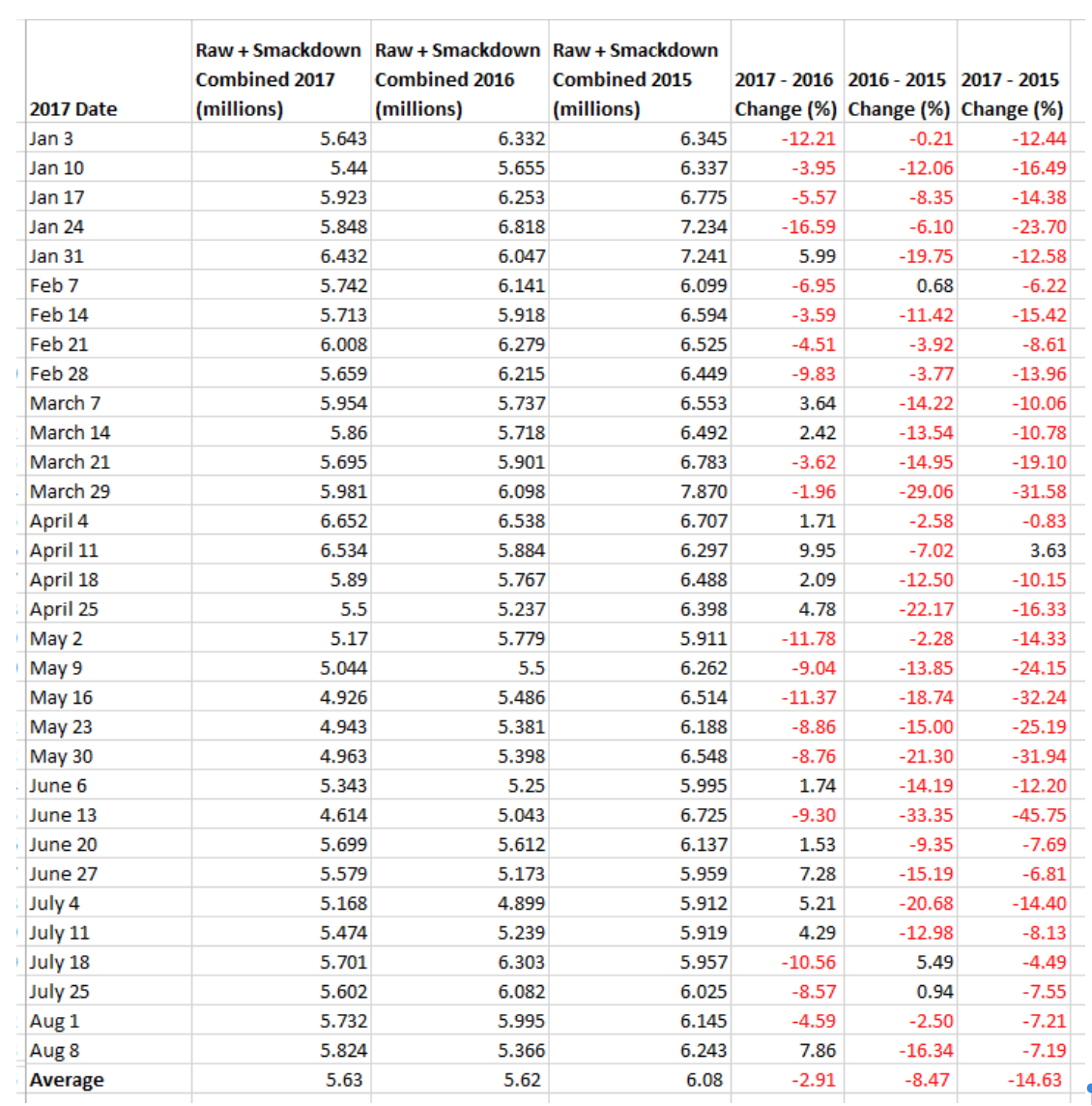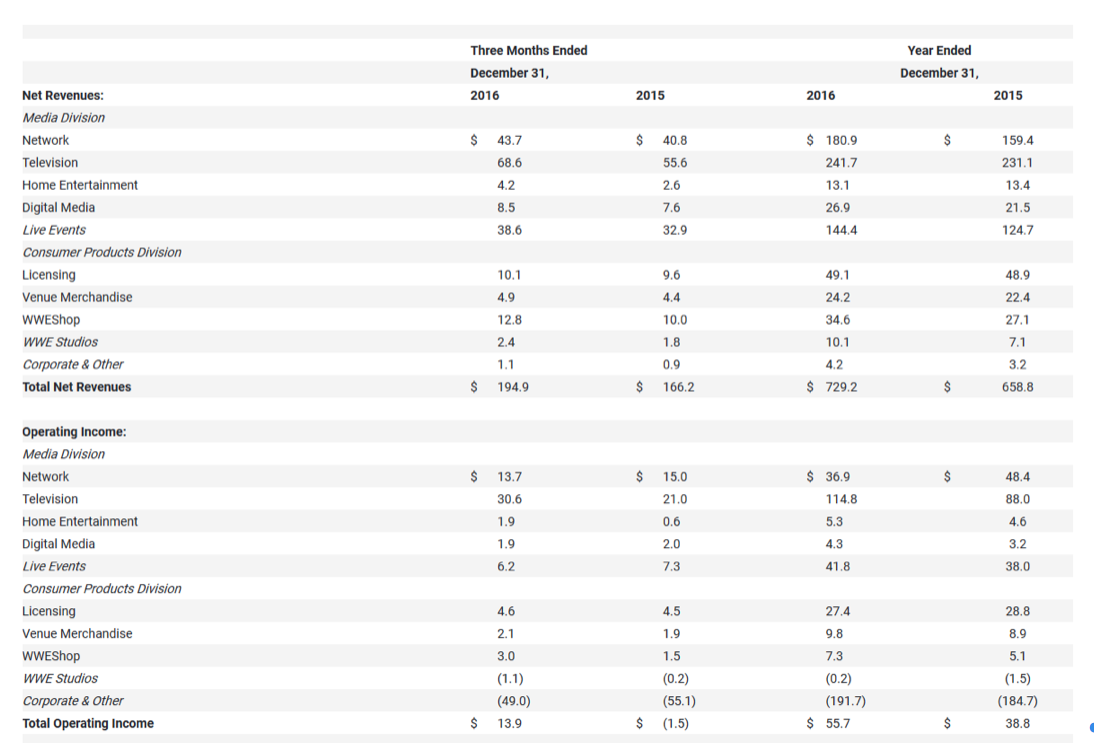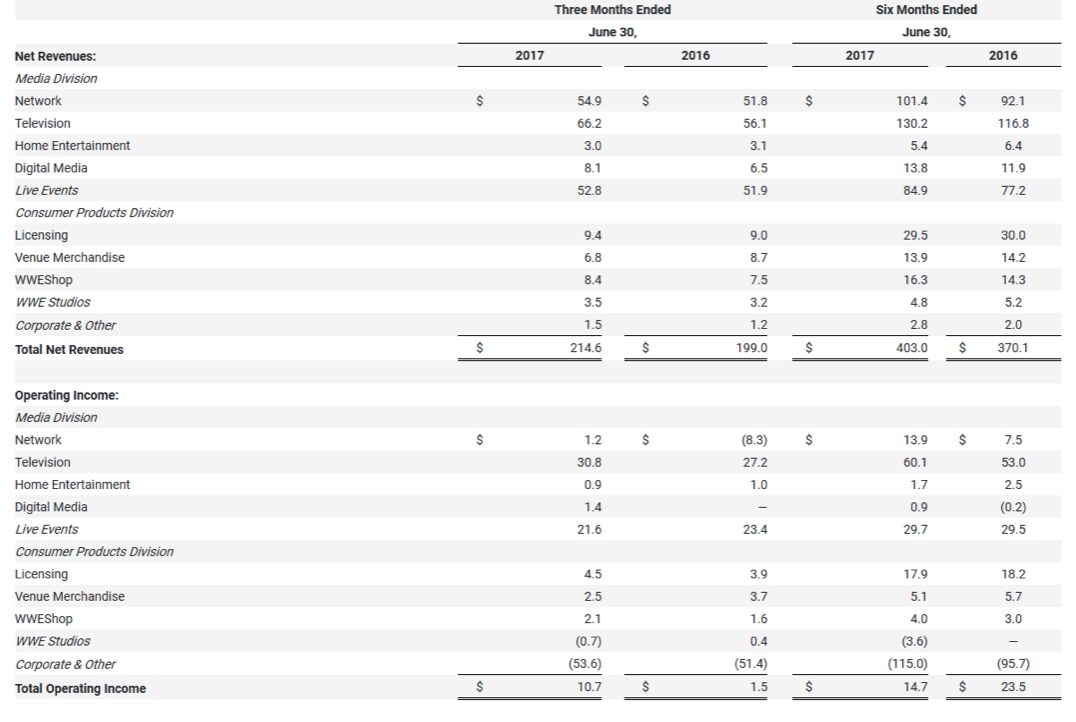
SPOTLIGHTED PODCAST ALERT (YOUR ARTICLE BEGINS A FEW INCHES DOWN)...
WWE’s TV ratings are a hot point of discussion these days with the re-introduction of the brand split and the current TV deal expiring in 2019. Over the last few years, viewership numbers have been in a constant decline, a trend that is obviously worrying for WWE.
In this latest edition of “Five Count”, I’m going to be looking at five lessons that can be learned from Raw and Smackdown’s TV ratings, largely focusing on the period since the brand split. We’ll look at whether the brand split has been a positive move for viewership figures, who really is a draw, putting these numbers into some context and then looking at why these numbers really are important and not an outdated metric.
Warning: numbers and tables alert!
(1) The Brand Split Effect
A little over a year ago WWE brought the brand split back into effect, dividing the roster up into two between Raw and Smackdown. This coupled with Smackdown moving to Tuesday and airing live was designed to increase the joint viewership of Raw and Smackdown every week. I’m sure WWE realised that a drop off in Raw’s viewership numbers was somewhat inevitable but the intention was that any hit Raw took would be made up for and then some by the gain to Smackdown’s viewership. That hasn’t happened.
| Impact of Brand Split on Average Raw & Smackdown Viewership | |||
| Pre Brand Split | Post Brand | Change | |
| Raw | 3.439 million viewers | 3.014 million viewers | -12.36% |
| Smackdown | 2.260 million viewers | 2.523 million viewers | 11.64% |
| Raw & SD Combined | 5.699 million viewers | 5.548 million viewers | -2.65% |
Yes the split has helped to boost Smackdown’s viewership figures. In the 52 weeks following the debut of Smackdown Live with the draft special, Smackdown has averaged 2.523 million viewers, a significant 11.64% upgrade from the 2.260 million viewers that the show averaged in the 52 weeks prior. Despite 8 of the 52 weeks scoring lower viewership figures compared to the same week the year before, Smackdown on the whole is watched by more people on a more consistent basis now. Which when you go live and give the show exclusive talent such as John Cena, A.J. Styles, Randy Orton and more, is less so a sign of success as it is a sign of avoiding disaster.
Where the brand split comes under scrutiny however, is when you look at the cost of those extra 263,000 viewers. In the 52 weeks following the draft, Raw has averaged 3.014 million viewers, a serious 12.36% slump down from the 3.439 million viewers that the show averaged the 52 weeks prior. So in order for Smackdown to gain an extra 263,000 viewers on average, Raw has been forced to lose an extra 425,000 viewers. That’s a cost of 162,000 viewers each week in order to get more people watching Smackdown.
Looking at the weekly combined viewership of Raw and Smackdown, you can see that the average viewership of both Raw and Smackdown combined each week dropped from 5.699 million viewers in the 52 weeks prior to the brand split, down to 5.548 million in the 52 weeks after, a 2.65% decrease. Furthermore, only 20 of the 52 weeks saw an improved combined viewership figure from the same week 12 months earlier. The brand split doesn’t look like a great success when you look at them numbers. Or you could argue that as a result of the brand split, the average combined viewership is only down 2.76% for the first 28 weeks of 2017 compared to down 12.78% for the same period in 2016 (up to the draft week).
So has the brand split had a positive impact on viewership? Technically no. You could however argue that it has helped to slow the rate of decline in viewership and argue it as a positive impact in that sense.
(2) The John Cena Effect
John Cena and Brock Lesnar are both in unique positions in WWE in that they come and go during the course of the year. What that allows is for us to see much more clearly the impact that each star has on the ratings of the show that they appear on. So who has the bigger impact, Brock Lesnar or John Cena?
| Average Viewership Since Brand Split | |||
| Without | With | Change | |
| Brock Lesnar | 2.989 million viewers | 3.101 million viewers | 3.75% |
| John Cena | 2.464 million viewers | 2.584 million viewers | 4.87% |
The answer is pretty unquestionably John Cena with a 4.87% increase on Smackdown viewership compared to a 3.75% increase on Raw viewership when Brock Lesnar is on the show. Now comparing Cena’s impact on Smackdown to Brock’s impact on Raw isn’t a totally like for like comparison and needs to be noted. What will be really interesting is if Cena’s impact to Smackdown’s viewership translates in a similar manner to his impact on Raw’s viewership, assuming his upcoming move comes to fruition as is rumoured.
| Average Viewership Since Brand Split Outside of WrestleMania Season | |||
| Without | With | Change | |
| Raw | 2.929 million viewers | 2.970 million viewers | 1.4% |
| Smackdown | 2.421 million viewers | 2.525 million viewers | 4.3% |
What’s even more interesting, however, is the impact on viewership outside of WrestleMania season (end of Monday Night Football up to and including the Superstar Shakeup Week). Raw’s viewership increases 1.4% from 2.929 million viewers without Brock to 2.970 million viewers with Brock. Smackdown’s viewership however increases 4.3% from 2.421 million up to 2.525 million when Cena is on the show. This suggests that the original 3.71% increase on viewership figure for Brock is somewhat inflated by being on the flagship show, along with being boosted by appearances during WrestleMania season by the likes of Goldberg and Undertaker.
| Average Viewership Since 2017 Superstar Shakeup | |||
| Without | With | Change | |
| Raw | 2.929 million viewers | 2.962 million viewers | 1.13% |
| Smackdown | 2.378 million viewers | 2.505 million viewers | 5.34% |
Taking it a step further and looking at each wrestler’s effect on viewership this year further cements the difference between Cena and Lesnar as TV draws. Since the Superstar Shakeup, Smackdown was averaging 2.378 million viewers. Since John Cena returned Smackdown is averaging 2.505 million viewers (2.54 million if you discount the 4th of July episode). That’s an immediate 5.34% increase upon Cena’s return. That number is even more remarkable when you factor in that they haven’t exactly been using him in anything hot since his return. It’s not a case of John Cena returning to work a hot program with A.J. Styles. This is very much an impact on ratings just to see John Cena regardless of what he’s doing.
Using the same time frame, Brock’s impact is much more minimal. From the Superstar Shakeup onwards, Raw’s average viewership without Brock on the show is at 2.929 million. However, when Brock is on the show, the viewership only increases 1.13% up to 2.962 million viewers. What’s really interesting is that coming out of Extreme Rules, the shows without Brock on them are actually outdrawing the shows with Brock on them at 3.079 million viewers compared to 2.962 million. Make of that what you will.
With an act like Roman Reigns, it’s almost impossible to accurately reflect his impact on viewership because he’s never off TV long enough for us to fairly do so. That said however, it’s interesting to note that the average viewership during Roman’s suspension (July 4th show ignored) was 3.132 million compared to 3.277 million between April 11 (first Raw after Raw after Mania) and June 20th (last Raw with Reigns before brand split), a 4.42% decrease. Granted a sample size of 3 weeks of TV isn’t enough to draw accurate evaluations but I thought that was interesting enough to drop in here.
Cena’s impact on viewership is undeniable. What’s also undeniable is his fading presence on WWE TV. WWE are very much transitioning into a post Cena era and need to be using Cena’s impact on viewership to be setting up for the future without him. It’s all well and good marvelling at the impact of his drawing power, but if it’s not used to assist anyone else in getting to that level then the returns of it are minimal. WWE should be looking at focusing on highlighting several acts they see money drawing potential in and really showcasing them on the episodes that Cena appears on. They need to use the extra viewers that Cena attracts and give them reasons to watch when Cena isn’t on the show.
*note: figures go up to and including August 8th 2017
(3) NFL Comparison
It’s easy to look at Raw’s viewership numbers declining and decide that business is bad, what they’re doing isn’t working and things need to change. But looking at figures in isolation isn’t great analysis. You need something to compare them to. And while comparison from year to year is a very valid point of comparison, it doesn’t paint a complete picture.
Every winter Raw goes head to head against Monday Night Football and takes an inevitable hit in viewership as a segment of their audience prioritise watching Football over Wrestling. Much has been made about not only the fall in people watching Monday Night Raw but also the fall in viewership for Monday Night Football on ESPN. So I thought it would be an interesting comparison to look at how the two sets of declining viewership compare with one another.
First of all, I’m comparing ratings rather than viewership figures here. I’m sure almost everyone reading this is aware of the declining subscription rates hitting ESPN and the subsequent cuts they’ve been forced to make in order to combat that. A big cause of that is ESPN no longer being as easily accessible on network packages to consumers, meaning that a lot of ESPN subscribers are faced with the ultimatum of either paying more or dropping ESPN. As a result, that will obviously directly impact viewership for ESPN programs. However, it won’t affect TV ratings because they’re formed based on how many people have access to watch the show. So if people are cord cutting then yes, viewership will dwindle, ratings won’t though.
| Annual Average Rating During Football Season | |||
| 2016 | 2015 | 2014 | |
| Monday Night Raw | 2.00 | 2.32 | 2.75 |
| Monday Night Football | 6.78 | 8.04 | 8.27 |
| *September 26th 2016 episodes ignored, up against Presidential Debate | |||
Looking exclusively at the difference in average ratings over the 12 weeks of Monday Night Football, you could be forgiven for thinking that Raw was performing well relative to the troubles of Monday Night Football’s ratings. And really, they actually did last season. The average rating over the 12 weeks for Raw was down 13.88% from 2015, compared to a 15.63% drop for Monday Night Football. So Monday Night Football was declining at a faster rate than Raw right?
What’s interesting to note is what happens when you take the average of the 7 weeks after the election was over. Raw’s average rating increases 1.5% resulting with an overall drop from 2015 of 12.54% now rather than 13.88%. Monday Night Football’s rating however increases 2.5% with an overall drop from 2015 of 13.56% now rather than 15.63%, a difference of 13.24% compared to a difference of 9.65% for Raw. So clearly the election had a significantly bigger hit on Monday Night Football’s ratings than it did on Raw’s ratings.
| Annual Ratings Change | |||
| 2016-2015 | 2015-2014 | 2016-2014 | |
| Monday Night Raw | -13.88% | -15.46% | -27.19% |
| Monday Night Football | -15.63% | -2.73% | -17.93% |
| *September 26th 2016 episodes ignored, up against Presidential Debate | |||
Where the ratings comparisons make less flattering reading for WWE is when you go back just one more year to 2014 and look at the ratings decline from 2014 to 2016. Monday Night Football saw a decline of 17.93% whereas Raw took a massive 27.19% hit. Yes you could put the 2016 to 2015 hit on the brand split but that doesn’t account for the 15.46% decline the year before.
Raw’s annual decline in ratings during football season isn’t pretty. However, the fact that Monday Night Football’s ratings dropped at a more rapid rate than Raw’s did last year is a positive takeaway for WWE. It helps to paint a sad picture in a slightly more positive light. A smaller decline from 2016 to 2015 than 2015 to 2014 is another positive for WWE. That said, all these positives really need to be re-evaluated at the end of this year’s run of Monday Night Football before WWE start looking at another decline as “well, at least it’s not as harsh a decline as Monday Night Football has”, otherwise we could be looking at a much bleaker picture for WWE with the decline from 2014 onwards expanding even further compared to Monday Night Football’s.
(4) “Popping A Rating”
The “what can be done to help ratings” is the question that every wrestling fan likely to read this seems to have an answer too. More big matches on TV! More week to week storylines! More of the women! Stop making my favourite wrestler lose!
The reality, however, is that “popping ratings” doesn’t have a lasting impact. In fact, very little actually does pop a rating these days. Recently they’ve given away marquee main events like John Cena vs. Shinsuke Nakamura for the first time ever and Roman Reigns vs Braun Strowman in a Last Man Standing match and the viewership has remained fairly consistent. Even when something like Goldberg’s return does produce a spike in viewership, there’s no lasting effect. Everything just goes back to the same trendline afterwards.
The problem is a big picture one. The average combined viewership for Raw and Smackdown hasn’t dropped 14.63% from 6.08 million in 2015 to 5.63 million so far in 2017 because of a lack of big events happening on Raw and Smackdown. It’s because fans have just stopped watching all together and that only happens when the problems are institutional and show wide. It’s because fans are tired of what the WWE product is at its core.
It’s all well and good hyping something like Roman Reigns vs. Braun Strowman for Raw but if viewers don’t have faith that the match will have a decisive outcome then who’s in the match doesn’t really matter. It’s all well and good hyping a title match for Smackdown but if viewers don’t think the belts mean anything then it doesn’t really matter. It’s all well and good bringing in amazing talent like A.J. Styles and Shinsuke Nakamura but if viewers don’t have faith that what they do matters and that they’ll see the best of them then it doesn’t really matter.
It’s also all well and good managing to pop a rating by bringing back Goldberg, for instance. However, if the ratings fall back to normal and the rate of decline continues after he’s gone, then guess what? It doesn’t really matter. The whole purpose of popping a rating should be that you get extra eyeballs on that episode and you then use that episode to give the fans watching for Goldberg a reason to tune back in the following week. Use that episode as a platform for two guys to go out and get themselves over in a killer match. WWE never manage to create a lasting impact that carries over into future weeks.
On a regular basis, when they do manage to pop a rating, it’s immediately followed the following week by a sharp drop. Goldberg’s return drew 3.13 million viewers, the following week dropped 9.94% down to 2.819 million. The episode of Raw with the Fatal 4 Way to crown Kevin Owens the new Universal Champion drew 3.413 million viewers, the following week dropped 10.08% down to 3.069 million. The Raw after WrestleMania last year drew 4.094 million viewers, the following week dropped 13.8% down to 3.529 million. The Superstar Shakeup this year on Smackdown drew 3.105 million viewers, the following week dropped 18.07% down to 2.544 million. The return of Undertaker on the 900th episode of Smackdown last year drew 2.725 million viewers, the following week dropped 8.07% down to 2.505 million. All of these drop offs are viewers that want to watch Raw and Smackdown live but WWE don’t give them enough of a reason to tune back in the following week once the special attraction has gone.
The reality of the problem is that until WWE are willing to step back and change the culture and the ethos of their shows, it’s hard to see the tide changing. They can bring back Goldberg, they can split the rosters, they can give away title matches on TV, they can give away marquee main events on TV. None of it matters because what’s at the root of all of it is still the same and that’s what’s driving viewers away.
(5) The Importance Of Watching Live
We’ve heard all the excuses for why viewership numbers and ratings are both going down. People are still watching just in different ways. Look at all the views WWE’s videos get on Social Media and on YouTube. Cool. The USA Network doesn’t care about them. They care about how many people are watching their programming live. And what they think should be important to WWE. With WWE’s TV’s deal expiring in 2019 and negotiations upcoming as we enter 2018, what’s important to NBC Universal better be important to WWE too. And what’s important to them is who is watching and if they’re watching live.
There’s no denying that live viewership figures aren’t a completely accurate representation of who is watching Raw these days. Even live plus same night figures don’t paint the full picture. The growth of DVR viewing means that people can and do watch their favourite shows at a time that best suits them and that’s not necessarily the same night that it airs. Plenty of WWE fans will go online to read what happened on the show and then decide if they want to watch the show, or more appropriately, how much of the show they want to watch.
Once fans get into that habit they become DVR viewers rather than live viewers. They’re still valuable to WWE because they’re still watching their content and are still potential money paying consumers, but they’re really not valuable to the TV network. They need live viewers in order to attract higher ad rates. DVR viewers have the ability to skip past the adverts (and what DVR viewer actually watches the adverts?) so advertisers don’t really care who is watching on DVR, and as a result, neither do the networks.
Source: http://corporate.wwe.com/investors/news/press-releases/2017/02-09-2017-133041348
Source: http://corporate.wwe.com/investors/news/press-releases/2017/07-27-2017-133134681
People can come up with their reasons for why viewership is down, but at the end of the day all that matters is that they are, and as a result, WWE’s negotiating power for the next TV deal takes a hit. A hit that could end up feeling like a Conor McGregor right hook.
TV revenue makes up a massive proportion of WWE’s profitability. In the first 6 months of 2017, Operating Income for Television stood at $60.1 million. To put that into context, the rest of WWE’s media division (Network, Home Entertainment & Digital Media), Live Events, Venue Merchandise and WWE Shop made up $55.3 million COMBINED. Similarly, for the whole of 2016, Operating Income for Television stood at $114.8 million, $9.4 million more than Network, Home Entertainment, Digital Media, Live Events, Venue Merchandise and WWE Shop put together.
It’s not at all a case of WWE worrying about not getting a new TV deal, but as you can see, the TV deal accounts for a huge proportion of WWE’s income. And it’s the easiest source of income for WWE too. Operating Income for Television represents 47.5% of Net Revenue. In comparison, the Operating Income for the Network represents 20.4% of Net Revenue and Live Events represent 29%. Any hit to that will seriously hurt not only WWE’s bottom line but also the confidence of their stakeholders.
It’s not just NBC Universal that are of great importance to WWE in terms of negotiating a new TV deal. In order for them to get the best possible deal they badly need another network to also enter the mix. Without that, WWE’s negotiating leverage is minimal. With the introduction of a new player in the mix, it becomes inevitable that WWE get a better deal. Despite all the fair reasons why WWE aren’t seen as super lucrative programming to networks, they’re essential to the USA Network remaining relevant. Raw and Smackdown are routinely two of the most watched shows on Mondays and Tuesdays and are critical pieces of USA’s portfolio.
USA will be desperate to retain WWE programming in 2019 but without an alternative network making a genuinely competitive counter offer to WWE, WWE are equally desperate to retain their slot on USA. Without being able to attract a bidding war for their programming, WWE are in the same position they were last time where they pretty much just have to accept what they’re offered. Their programming only becomes really valuable when another Network decides that they also want to buy it. That didn’t happen during negotiations for the current deal and WWE really haven’t enhanced their position in the time since. Ratings are significantly down and they’re still faced with the issue of an unappealing audience demographic in the eyes of advertisers.
So to the people who argue about how TV ratings don’t really matter anymore and how WWE’s Social Media numbers counteract the decline from TV; cool. Good luck making that argument with networks during next year’s negotiations.
NOW CHECK OUT THE PREVIOUS COLUMN: FIVE COUNT: Five Lessons Wrestling Bookers Can Learn from New Japan from Roster Hierarchy to Purpose of Veterans







Leave a Reply
You must be logged in to post a comment.